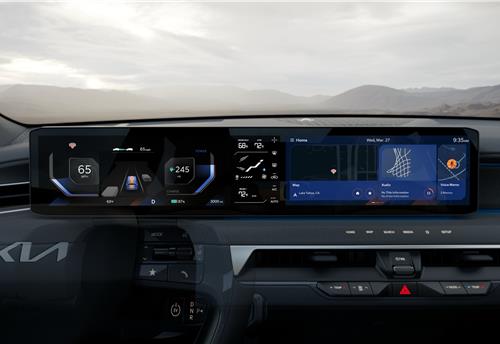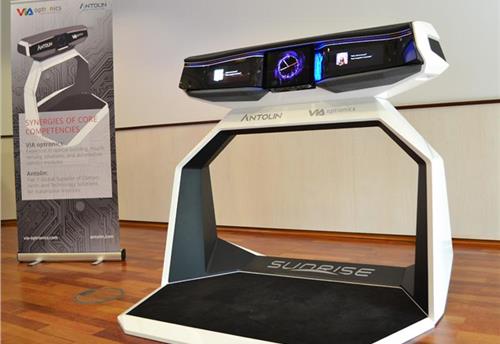ZF reveals its cockpit concept at CES
ZF is demonstrating four innovative approaches to the human-machine interface (HMI) as part of its Cockpit Concept.
Reliable and clear communication between the driver and the vehicle is critical for greater safety and increased comfort for autonomous driving. German component supplier ZF is demonstrating four innovative approaches to the human-machine interface (HMI) as part of its Cockpit Concept.
“Automated driving will revolutionise daily driving over the next 10 years,” says Dr Harald Naunheimer, Head of Corporate Research and Development at ZF. “Our HMI functionalities fulfill central quality criteria for automated driving. The first is providing the most comprehensive, precise, and redundant information on the state of the driver and, secondly, intuitive interaction.”
Sensitive steering wheel
Legally, today’s drivers are responsible for taking back control of the car from autopilots at any time after a certain warning period. The multifunctional steering wheel from ZF TRW simplifies the safe transfer of the wheel using two special functions. The first is integrated hands on/off detection at any time so the car knows when the driver actually has a firm grip on the wheel. The second is an LED display that shows a kind of visual countdown to let the driver know precisely when he or she is back in complete control of the vehicle. This process can be shortened at any time by pressing the additional “Push-to-drive” button on the ZF steering wheel. This allows the driver to take back control of the vehicle immediately.
Noticeable difference
With the patented Swipetronic, ZF can offer an equally smart and high-quality shift-by-wire alternative for automatic transmissions. One central feature is a new kind of touch display that is based on the principle of electrostatic charge. This enables flat, virtual buttons or switches to be touched just like the real thing. Unlike most previous screens, drivers no longer have to take their eyes and attention off the road in order to select the desired function. And using the software alone, the shift mode for transmission control and the corresponding haptic feedback can be adapted to meet almost any and all specific customer needs – always under the premise of maximum operating safety.
In the ZF Cockpit Concept, not only the gearshift systems, but almost all traditional operating devices have been replaced by a touchscreen operating concept based on this new display technology. This, too, consequently opens up the option of individual operating functions appearing on any preferred area of the HMI unit. They are actuated by virtual buttons of the most diverse texture, but feel real to the fingertip.
Recording the driver’s attention
Particularly when cars are on the road in highly automated mode, driver monitoring becomes significant. An important tool for this is the advanced, camera-based facial recognition feature. For example, during autopilot mode, it could determine reliably and in real-time whether the human driver is alert enough or at all capable of taking back control of the vehicle. Ultimately, it checks whether the driver has his face turned to or away from the current road situation. Additionally, the facial recognition feature, with the aid of smart algorithms, can be used to identify the emotional state of the driver and to support the driver accordingly.
Assisting belts
ZF shows how passive safety systems to date have been transformed into active helpers and communications tools with its new seatbelt system consisting of a buckle lifter (Active Buckle Lifter – ABL) and seatbelt tightener (Active Control Retractor – ACR). The combined belt system ensures first of all that the belt is always tight enough to provide the best possible safety. Secondly, when networked with other electronic assistance systems, such as the Automatic Emergency Brake (AEB), it pulls the belt even tighter if a collision appears unavoidable. Derived from this is a supporting feature for automated driving shown in the ZF Cockpit Concept: By generating highly frequent, insistent pulsations, the seatbelt also clearly informs the driver, if necessary, that action on his part is required.
More from CES:
- Ford aims for drone-to-vehicle tech to tackle emergency situations
- Volvo Cars and Ericsson developing intelligent media streaming for autonomous cars
- Volvo and Microsoft reveal new wearable control device at CES
- Bosch displays new haptic touchscreen technology
- Toyota Research Institute to develop next-gen autonomous tech
RELATED ARTICLES
Marelli Talbros Chassis Systems wins Rs 1,000 crore business from European OEM
The order, to be executed over an eight-year period, is for the supply suspension arms tailored for both conventional in...
Kia launches customised NBA display themes for North American market
Display Themes is a customised service that supports a personalised vehicle experience, allowing users to customise the ...
Antolin and VIA Optronics unveil versatile vehicle cockpit concept
The Sunrise vehicle concept cockpit, which is engineered for seamless transitions between manual and autonomous driving ...





 By Autocar Pro News Desk
By Autocar Pro News Desk
 05 Jan 2016
05 Jan 2016
 5667 Views
5667 Views









